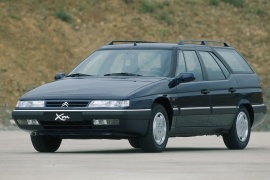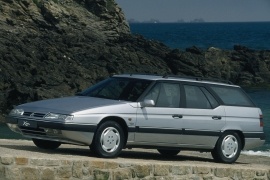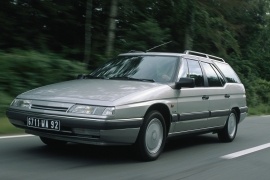CITROEN XM Break Models/Series Timeline, Specifications & Photos
First production year: 1992
Engines: Gasoline, Diesel
Body style: Wagon (station wagon, estate, combi, touring)
By 1997, Citroen was already forced to desperate measures to increase the global XM sales and introduced a second and final facelifted version.
When it was introduced in 1989 as a replacement for the CX, it was a revolution that fired up the market, and it became an instant success that lasted for a year and a half until the technical issues started to spoil the car's image. The French carmaker introduced a facelifted version in 1994, but without solving the technical problems. From there on, the XM's sales went down. In 1997, Citroen made a last facelift for the entire XM range, including the station wagon.
For the 1997 version, the French didn't want to pay anything to the original designer, Bertone, and decided to keep the car as it was. Thus, the carmaker didn't spoil the XM's look. For the station wagon version, Citroen kept the same tall tailgate and smoked taillights. To justify their money, the design department offered a choice of new hubcaps.
With an increased demand for safer cars, the carmaker found a smart way to convince its customers by introducing side airbags for the XM. The decision was right, in terms of safety but not in terms of sales. Citroen found itself in an even more difficult situation, but it still didn't fix the Hydractive II suspension that made so many cars failing on the roads.
If the design and safety couldn't make the car sell better, Citroen thought that more power would do the trick. It installed a new 3.0 V-6 engine under the hood. The XM was sold in smaller numbers than the company hoped for, and it was axed from the assembly lines in 2000. It was already an old vehicle, by those times standards.
In 1994, Citroen introduced a facelift for its flagship range, the XM, and along with the "Berline" version, it upgraded the station wagon as well.
Citroen had high hopes for the XM, and those were not achieved by 1994 when the lineup was refreshed. Even though it was all the necessary attributes to become a best-selling model, its sales figures were below expectations.
The carmaker employed Bertone Studio to design the car, and the final result was an unusual-looking vehicle with straight lines and abrupt angles. The 1994 model-year featured a new grille with two larger gaps than its predecessor. A long, sculptured line crossed the vehicle from headlights to taillights, and the carmaker installed the door handles in that. At the back, the step over the rear door panels made a connection to the trunk area and rear quarter panels.
Inside, the dashboard design was completely changed. While the non-facelifted version featured angular lines, which were on the same page with the exterior, the 1994 model sported rounded shapes. Moreover, the carmaker installed dual airbags to increase passengers' protection.
Under the hood, Citroen offered a choice of five engines ranged between 110 hp and 170 hp. The latter was the PRV, 3.0-liter V-6 gasoline unit developed together with Ford in the late '70s.
When Citroen decided to replace the CX model, it faced a difficult question: replaced it with what?
The answer came in 1992 when the carmaker introduced the wedged-shape XM on the market, and it looked completely different than its predecessor. Bertone Studios designed the car, and Citroen offered it in two shapes: sedan and station wagon. The latter was highly appreciated by those who needed big trunks and comfortable rides.
With a wedged-shape look, the XM featured a narrow front end with slim headlights and almost no visible grille. The extended roof was ended into a sloped tailgate. A long, sculptured line crossed the vehicle from headlights to taillights, and the carmaker installed the door handles in that. At the back, the step over the rear door panels made a connection to the trunk area and rear quarter panels.
Inside, the designer kept the same theme of angular shapes. Even the steering wheel featured a squared center. The XM Wagon offered room for up to five adults with more than decent legroom and headroom. Its trunk offered up 719 liters (25.4 cu-ft), with the rear bench in normal position.
Under the hood, Citroen offered a choice of three gasoline and two diesel engines. The carmaker paired them with either a five-speed manual or an automatic gearbox.


